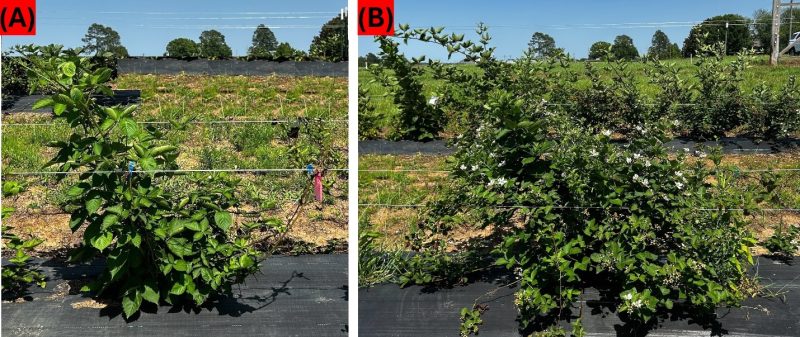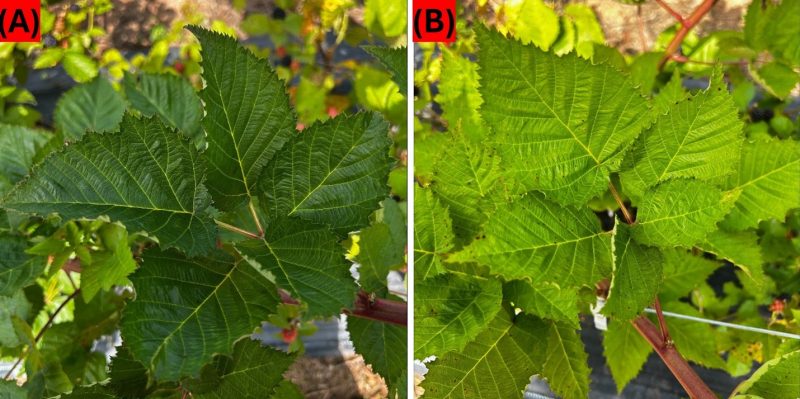Muhammad Shahid, Carlos Eduardo Aucique-Perez, and Shahid Iqbal, Horticultural Science Department, North Florida Research and Education Center, UF/IFAS, Quincy, FL
Nitrogen (N) plays a vital role in the growth and development of blackberry plants by supporting vegetative growth, improving yield, and enhancing overall plant health. Plants absorb N primarily in the form of nitrate (NO₃⁻) and ammonium (NH₄⁺) from the soil, stimulating various physiological processes, including leaf expansion, root development, and reproductive success. An adequate nitrogen supply in blackberries is important during early spring for cane growth, and later in the season for optimal fruit size and yield. Effective N management involves balancing supply with crop demand, optimizing fertilizer timing, and minimizing losses through leaching, volatilization, and denitrification. This balance not only boosts agricultural productivity but also reduces the environmental impact of nitrogen runoff, which can lead to water pollution and greenhouse gas emissions. Consequently, adopting precision agriculture practices, integrating organic amendments, and employing nitrogen-efficient crop varieties are critical for sustainable crop production. (Figure 1).

Figure 1. Role of nitrogen in plant growth and development. (A) improper nitrogen leads to stunted growth (B) Proper nitrogen availability in plants shows vigorous growth and higher flowering. Credit: Shahid Iqbal, UF/IFAS
–
Effect of Nitrogen deficiency and excess in blackberry plants
In blackberries, both N deficiency and excess can negatively impact plant health and fruit quality. For optimal growth and satisfactory performance, blackberry plants typically require a leaf nitrogen (N) content ranging from 2.2% to 3.0% of leaf dry matter. When N levels fall below this threshold, plants often exhibit N deficiency, initially characterized by foliar chlorosis (yellowing). In more severe cases, reddish patches may develop across the leaf blade as anthocyanin concentrations increase. N deficiency symptoms typically appear first on older leaves, progressively affecting younger ones. Nitrogen deficiency in blackberry plants leads to significant reductions in growth and yield. Specifically, it causes a decrease in internode length, increase in fruit drop, and decrease in individual fruit weight. The cumulative effects of N deficiency on both vegetative growth and fruit development can be severe, ultimately reducing overall plant productivity by up to 70% in moderately deficient plants, and as much as 75% in those with severe deficiency (Fig 2).
On the other hand, excessive N leads to overgrowth in plants, characterized by long internodes, thinner stems, dark green leaves, low yield, poor fruit quality, reduced conservation potential, and a greater risk of diseases such as cane blight and leaf spot. High N rates applied to blackberry plants induce an imbalance in other nutrient minerals, showing significant reductions in manganese (Mn), potassium (K), calcium (Ca), and magnesium (Mg), along with an increase in copper (Cu). Therefore, for optimal performance, blackberry growers should aim for a balanced nitrogen program based on soil and tissue testing.

Figure 2. Effect of nitrogen on the blackberry leaves. (A) sufficient nitrogen (B) deficient nitrogen. Credit: Shahid Iqbal, UF/IFAS
–
General guidelines for Nitrogen management in blackberry crops
Nitrogen management is critical for blackberry cultivation in the Florida Panhandle, where a long growing season and sandy/clay soils can influence nutrient dynamics. Blackberry growers typically apply high nitrogen rates to enhance yield and quality indexes for this crop. As a general guideline, nutritional management is based on the 5R’s concept: 1) the Right fertilizer source, 2) the Right rate, 3) the Right timing of application, 4) the Right placement, and 5) the Right moisture level. Regarding the right source, previous studies show that blackberry plants benefit from NH₄⁺ nutrition, which boosts biomass, chlorophyll, antioxidant activity, and increases TSS accumulation. Selecting the appropriate nitrogen application rate is essential for enhancing blackberry production. Studies have recommended applying a total of 30–50 lbs./ac N in the first year of production regardless of plant growth habit. Beginning in the second year of production, N fertilization should be increased by 40%, and 40 to 60% for semi-erect and erect cultivars, respectively in with the rate of N fertilization remaining constant in subsequent years. Proper nitrogen application timing is critical for optimizing crop productivity and minimizing nutrient losses. In blackberry production, nitrogen application should be split such that applications coincide with key growth stages and with the total N applied not exceeding the rates mentioned above. A study on the ‘Shuofeng’ cultivar indicated that applying 20–40 g of ammonium sulfate per plant during early bud burst, flowering, and fruit development stages yields the best results in terms of productivity and fruit quality. The optimal placement for nutrient application is typically within the root zone or just ahead of the expanding root system to maximize nutrient uptake.
–
When and how to collect leaf samples for N testing
In blackberry, tissue concentration N changes rapidly during the early growing season, so collecting the leaf samples from late June to July is recommended as the concentrations are mostly stable. Tissue sampling other than during the stable period is not recommended to determine the nutrient status. Always collect the leaf samples from newly expanded leaves in an adequate amount, 12 inches from the top, and one leaf per primocane. Collect the leaf samples with the petiole and ensure they are disease-free. After collecting, put the leaves in the paper bags and send them to the lab for analysis.
–
Current research on multi-location N management trial in blackberry
The Fruit Physiology Lab at North Florida Research and Education Center is conducting a multi-location nitrogen (N) management project in blackberry across key production regions (North, Central, and West Central Florida) to evaluate the effects of different N application rates and timings on plant growth, yield, fruit quality, and nutrient use efficiency. This project is funded by the Florida Department of Agriculture and Consumer Service. This coordinated effort includes replicated field trials in diverse environments to capture site-specific responses and refine regionally relevant recommendations according to soil and climate type. The study aims to identify optimal N strategies that support sustainable blackberry production by improving productivity while minimizing environmental impacts. Through standardized data collection and collaborative analysis, this trial generates robust, science-based guidelines for adoption.
- Boosting Citrus Cold Hardiness with Seaweed Extract Biostimulants - November 21, 2025
- Optimizing Nitrogen Use for Sustainable Blackberry Production in the Florida Panhandle - May 22, 2025
- Citrus Sunburn: A Physiological Disorder - May 17, 2024
